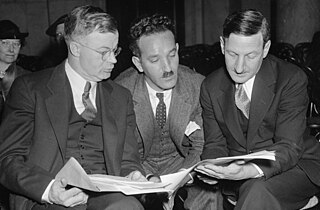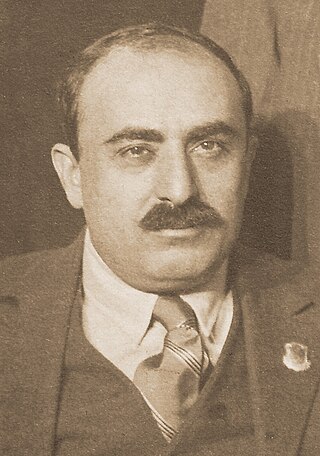Related Research Articles

David Dubinsky was a Belarusian-born American labor leader and politician. He served as president of the International Ladies Garment Workers Union (ILGWU) between 1932 and 1966, took part in the creation of the CIO, and was one of the founders of the American Labor Party and the Liberal Party of New York.

William Zebulon Foster was a radical American labor organizer and Communist politician, whose career included serving as General Secretary of the Communist Party USA from 1945 to 1957. He was previously a member of the Socialist Party of America and the Industrial Workers of the World, leading the drive to organize the packinghouse industry during World War I and the steel strike of 1919.

Earl Russell Browder was an American politician, spy for the Soviet Union, communist activist and leader of the Communist Party USA (CPUSA). Browder was the General Secretary of the CPUSA during the 1930s and first half of the 1940s.

The International Ladies' Garment Workers' Union (ILGWU), whose members were employed in the women's clothing industry, was once one of the largest labor unions in the United States, one of the first U.S. unions to have a primarily female membership, and a key player in the labor history of the 1920s and 1930s. The union, generally referred to as the "ILGWU" or the "ILG", merged with the Amalgamated Clothing and Textile Workers Union in the 1990s to form the Union of Needletrades, Industrial and Textile Employees (UNITE). UNITE merged with the Hotel Employees and Restaurant Employees Union (HERE) in 2004 to create a new union known as UNITE HERE. The two unions that formed UNITE in 1995 represented 250,000 workers between them, down from the ILGWU's peak membership of 450,000 in 1969.

Juliet Stuart Poyntz was an American suffragist, trade unionist and communist spy. As a student and university teacher, Poyntz espoused many radical causes and went on to become a co-founder of the Communist Party of the United States (CPUSA). Later she began working as an intelligence agent for the Soviet Union, travelling secretly to Moscow just as some of her comrades were being executed in Joseph Stalin's Great Purge, after which she resigned from the party. This is widely assumed to have led to her unexplained disappearance in New York City in June 1937 as the likely victim of an assassination squad, possibly because she had been associating with Trotskyists.

Nathan Witt, born Nathan Wittowsky, was an American lawyer who is best known as being the Secretary of the National Labor Relations Board (NLRB) from 1937 to 1940. He resigned from the NLRB after his communist political beliefs were exposed, and he was accused of manipulating the Board's policies to favor his own political leanings. He was also investigated several times in the late 1940s and 1950s for being a spy for the Soviet Union in the 1930s. No evidence of espionage was ever found.

August Tyler (1911-2011) was an American socialist activist of the 1930s, a labor union official, author, and newspaper columnist. Tyler is best remembered as a leading American labor intellectual of the post-World War II era and as the author of a history of the International Ladies Garment Workers Union.
Bella Dodd was a teacher, lawyer, and labor union activist, member of the Communist Party of America (CPUSA) and New York City Teachers Union (TU) in the 1930s and 1940s, and vocal anti-communist after her expulsion from the Party in 1949.

Israel Amter (1881–1954) was a Marxist politician and founding member of the Communist Party USA (CPUSA). Amter is best remembered as one of the Communist Party leaders jailed in conjunction with the International Unemployment Day riot of 1930 and as a frequent candidate for public office, including three runs for Governor of New York.

The Lovestoneites, led by former General Secretary of the Communist Party USA (CPUSA) Jay Lovestone, were a small American oppositionist communist movement of the 1930s. The organization emerged from a factional fight in the CPUSA in 1929 and unsuccessfully sought to reintegrate with that organization for several years.

Charles S. "Sasha" Zimmerman (1896–1983) was an American socialist activist and trade union leader, who was an associate of Jay Lovestone. Zimmerman had a career spanning five decades as an official of the International Ladies Garment Workers Union. During the early 1970s, Zimmerman and Bayard Rustin were national Co-Chairmen the Socialist Party of America and the Social Democrats USA.

Alexander "Alex" Trachtenberg was an American publisher of radical political books and pamphlets, founder and manager of International Publishers of New York. He was a longtime activist in the Socialist Party of America and later in the Communist Party USA. For more than eight decades, his International Publishers was a part of the publishing arm of the American communist movement. He served as a member of the CPUSA's Central Control Committee. During the period of McCarthyism in America, Trachtenberg was twice subject to prosecution and convicted under the Smith Act; the convictions were overturned, the first by recanting of a government witness and the second by a US Circuit Court of Appeals decision in 1958.
Jack Hardy, born Dale Zysman, was a 20th-Century Communist author labor leader as "Jack Hardy" and a teacher and board member of the New York City Teachers Union under his birth name "Dale Zysman": investigation by the New York Board of Education led to public awareness that the two names belonged to one person and subsequent expulsion from the school system in 1941.

James Patrick Cannon was an American Trotskyist and a leader of the Socialist Workers Party.
Henry Joseph Foner was a 20th-century Jewish-American social activist and president for more than two decades of the Joint Board, Fur, Leather and Machine Workers Union (FLM).

William Frauenglass was a high-school teacher to whom Albert Einstein wrote a letter on academic freedom, published in the New York Times and much publicized at the time.
The New York City Teachers Union or "TU" (1916–1964) was the first New York labor union for teachers, formed as "AFT Local 5" of the American Federation of Teachers, which found itself hounded throughout its history due largely to co-membership of many of its members in the Communist Party USA (CPUSA).
The New York City Teachers Guild (1935-1960), AKA "Local 2, AFT" as of June 1941, was a progressive labor union that started as breakaway from the New York City Teachers Union and later merged into the United Federation of Teachers.
Charles Dirba was a Latvian-American co-founder of the Communist Party of America (CPA) and Communist Party USA (CPUSA).
Nat Ganley, or Nat Kaplan, was socialist and then communist journalist who become a union organizer in the 1930s, particularly for the United Auto Workers of America and was tried and convicted in 1954 for violating the Smith Act.
References
- 1 2 3 4 5 6 7 8 9 10 11 12 13 14 15 16 "Guide to the Charles James Hendley Papers TAM.109". New York University. 9 May 2018. Retrieved 26 October 2018.
- 1 2 3 4 Zitron, Celia Lewis (1969). The New York City Teachers Union, 1916-1964. Humanities Press. p. 88 (bio), 129 (split), 181 (policy). Retrieved 26 October 2018.
- 1 2 3 4 5 6 "Subversive Influence in the Educational Process". US GPO. 1952. pp. 22–23 (Dodd), 23 (Zysman), 104–111 (Hendley). Retrieved 26 October 2018.
- ↑ "Senate Internal Security Subcommittee 1952-1953". Brooklyn College. Retrieved 26 October 2018.
- ↑ Herbert, William A.; Apkarian, Jacob (2017). "Everything Passes, Everything Changes: Unionization and Collective Bargaining in Higher Education" (PDF). Higher Education. Retrieved 26 October 2018.
{{cite journal}}: Cite journal requires|journal=(help) - 1 2 3 Robert Justin Goldstein, ed. (13 May 2016). Little 'Red Scares': Anti-Communism and Political Repression in the United States, 1921-1946. Routledge. p. 295 (puppet), 300 (1937), 313 (Rapp statement). ISBN 9781317104148 . Retrieved 26 October 2018.
- ↑ Hendley, Charles J. (1939). "Unionism in the Educational Field". eachers College Record. Retrieved 26 October 2018.
{{cite journal}}: Cite journal requires|journal=(help)